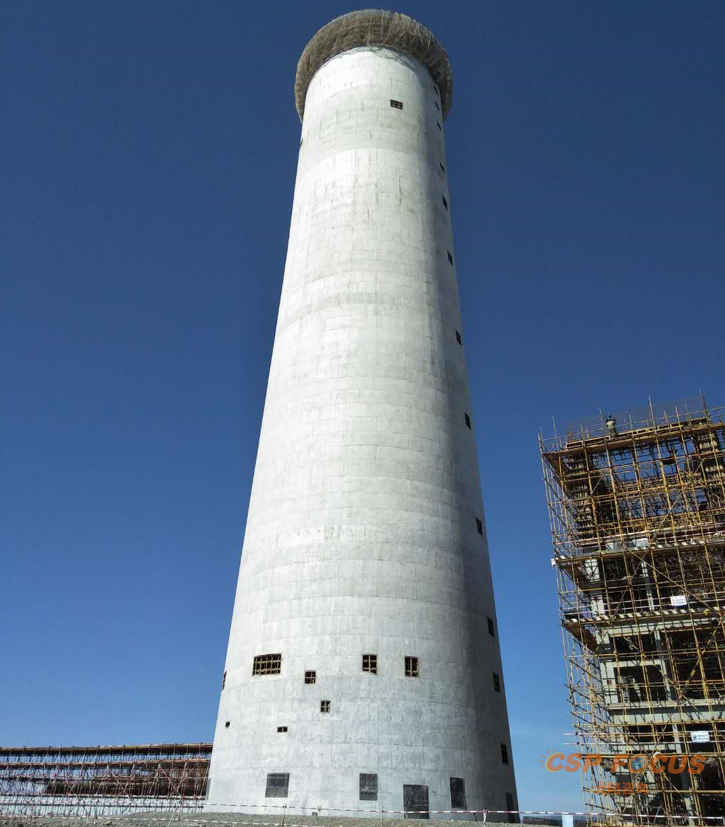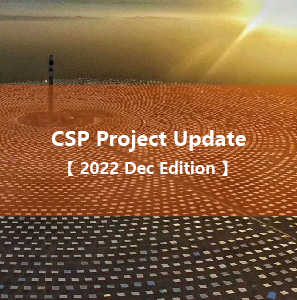Stellio Heliostat Concentrated Solar Power Project Goes Online in China
2020.03.03 From: HELIOSCSP
One of the world’s first molten salt tower concentrated solar power (CSP) projects that uses a “Stellio” heliostat was grid-connected at the end of December in China’s Xinjiang province near the Mongolian border. The 50-MW Hami pilot project developed by Chinese state-owned company China Power Engineering Consulting Group marks a major milestone for the novel heliostat design, which went from concept to construction in a mere five years.
The project, whose solar field stands particularly because of the adoption of SBP’s Stellio heliostat, is one of China’s first batch of CSP demonstration projects and also the first CSP demonstration project in Xinjiang. With a total investment of 1.6 billion yuan, it started construction on October 19, 2017 and is planned to generate electricity in April 2019.
It is estimated that after the completion of construction the project will be capable of generating 1.9835 billion kWh of clean power, which is superior to PV and wind power generation in quality. The project will guarantee a stable electricity supply and well regulate the power grid. Meanwhile, as one of China’s first batch of CSP demonstration projects, it is of great significance to promote the development of Hami’s related industries in the future.

The $226 million Hami project is a central receiver plant that uses molten salts as heat transfer fluid and as a thermal storage system. According to its developer, the project operates with a 43% thermal efficiency under ambient temperatures of 19C, and an air condenser backpressure of 8.5 kPa. When in operation, the thermal efficiency of the thermal storage and heat transfer system reaches 99%—which means the 1,430 MWh storage system can run the turbine at full output for 12 hours.
According to a recent paper authored by experts involved in the Hami project, the design concept took shape when German structural engineering and consulting firm Schlaich Bergermann Partner (sbp) set out to address an increasing interest in solar tower technology in 2010. The firm partnered with South Africa’s SASOL Technology to further develop its design, and the partners eventually settled on calling it “Stellio,” a name that refers to a sun-loving agama lizard.
The Hami project, which was built in roughly two years, is China’s sixth large-scale commercial solar thermal power project, according to the China Solar Thermal Alliance, and it brings the country’s total CSP capacity to 350 MW. However, development of its innovative heliostat began much earlier.
When SASOL withdrew from renewables to focus on its chemicals business, sdp joined forces with Spanish CSP experts Ingemetal Energias and Masermic. The companies built the first Stellio prototype (Figure 2) at the Plataforma Solar de Almería in Spain in 2014, equipping it with sensors. That project, sdp said, confirmed and allowed for verification of Stellio’s “outstanding optical and tracking performance.” At least four other prototypes were also tested, each building on lessons learned.
CPECC Hami 50 MW Molten Salt Tower Project is under intensive construction recently. The latest progress is that the pre factory area of the project has been capped. The tower has been constructed to 94 meters and will be capped at the end of September as planned.
At present, the A-B frame of the main factory frame has been on the top, and the assembly workshop construction is more than 70% complete. The erecting of the heliostat pillar in solar field and the assembly work of the molten salt tank steel structure have started. Besides, the equipment bidding has been basically completed. The main equipment such as generators, steam turbine and the solar field has entered the supply phase.
However, the consortium’s initial efforts to build a first-of-its-kind plant at Redstone in South Africa’s Northern Cape Region collapsed, so it collaborated with Dongfang Boiler Group (DBC), and eventually won a tender in 2016 to build a project at the Hami solar field. As sdp notes, Stellio was especially attractive even then.
Its winning attribute is its pentagonal design, which greatly reduces the subtle but ongoing oscillation from wind load. The design essentially comprises 10 cantilever arms and a central hub, which allows for “a more homogenous stiffness distribution compared to rectangular structures and results in a very efficient structural system, [that is], it provides low deformations and thus high optical performance at low specific weight. Its roundish shape reduces shading and blocking and allows for a compact field layout,” the firm explained.
However, the design is also partly derived from well-proven parabolic trough technology. “The cantilever arm [is] welded from hollow box sections—easy to fabricate and with optimum stiffness per weight.” It also features five rings of purlins that carry the mirrors; the purlins are made from a cost-effective sheet metal. The hub and the parts of the kinematic system are welded from plates.
“The main advantage of the Stellio kinematic system with two inclined axes is that cost-efficient linear actuators can be used for both axes and that tracking errors due to drive backlash are eliminated for [most] heliostat orientations,” sdp added.
The whole structure is then hot dip galvanized to ensure long-term corrosion protection. Finally, it uses 10 mirrors (made from 4-millimeter-thick float glass) as well as a central mirror—which altogether form a 48.5-square-meter reflecting surface. The Hami solar field turned out to be ideally suited to the Stellio design because it features a “slight overall slope” that lends well to a staggered field configuration. The field surrounding the 94-meter-high solar tower can host 14,500 heliostats.
According to SolarPACES, the International Energy Agency’s CSP research arm, how quickly the concept progressed from “lab to commercial” is remarkable. “The biggest obstacle to advancing potential cost-cutting improvements in novel CSP technologies is getting them deployed in commercial projects. Risks are high when every CSP plant must be built at utility-scale and must make money right away,” it noted. However, the project also benefited greatly from being built in China, which as Solar PACES noted, “takes a different approach to new technologies that favors giving novel designs a tryout. Its first CSP projects are demonstration projects, yet they are being built at full size to allow real-life engineering issues to show up so they can be resolved at commercial scale.”
The 50-MW Yumen project in China, for example, is testing a “beam-down” dish CSP, a technology that promises to cut CSP power costs by 30%. “If beam down works, it could greatly simplify solar hydrogen thermochemistry, because a focal point on the ground is conducive to another innovation to cut renewable hydrogen costs by combining the solar receiver/reactor with thermal storage at ground level, where the thermochemistry for splitting water is best carried out,” the organization noted. Another phase of the Yumen project is also testing a silicon-based heat transfer fluid (HTF) for trough CSP in a project spearheaded by Chinese firm Royal Tech CSP, another SolarPACES award winner. That’s notable because “Silicon can get much hotter than today’s 400C standard heat transfer fluid for trough CSP, so this Si-HTF greatly improves the efficiency of parabolic trough CSP,” SolarPACES said.
Upcoming CSP events:
5th CSP Focus MENA 2020(June.23-24,Dubai, UAE)
10th CSP Focus China 2020 (Beijing China)
More CSP news and reports please visit www.cspfocus.cn
or CSP Focus social media on LinkedIn, Twitter, Facebook.
More from CSP Focus
NextCrescent Dunes concentrated solar power plant uses molten salt
Negev Energy to build a 121 MW thermo solar power plant in Israel
Concentrated Solar Power startup Heliogen scores $39 million in DOE funding
Hyperlight Energy Launches Tectonic Sun to Decarbonize Oil Wells
EPC bidding for China Yumen Xinneng 50MW beam down MS Tower CSP project opens this week
Morocco’s Noor Ouarzazate Concentrated Solar Power plant could power over one million homes- CNN
Concentrated Solar Power experts warn capex gains needed to ensure desalination future
Leave your thoughts here
Reports(Member Only)
See more+-
CSP Focus Membership Proposals
We are now proposing CSP Focus Membership, hoping to better serve our members to keep pace with the latest updates of ongoing CSP projects worldwide, and to establish and maintain business relations with major shareholders of the projects. CSP Focus offers to Membership exclusive access to:1. Daily/Weekly update and analysis on CSP policies, projects, technologies, market trend and corporate relea
-
The Latest CSP Focus Monthly Update
Join CSP Focus Membership to Get the Latest CSP Focus Monthly Update December Edition.
-
CSP Project Monthly Update 2022 December Edition
CSP Focus is presenting CSP Project (China) Update 2022 December Edition.Detail report is available for CSP Focus Membership.
-
Presentations-CSP Focus China 2021
The Report is for CSP Focus Members only.
Upcoming Events
See more+-
12th CSP Focus China 2022
2022.04.21-22 Beijing
-
11th CSP Focus China 2021
2021.10.28-29 Beijing
-
10th CSP Focus China 2020
2020.10.22-23 Beijing, China
Project Updates
See more+-
Lanzhou Dacheng Dunhuang CSP Project
Asia Pacific-China,Operational,Parabolic Trough
-
Luneng Haixi 50MW Molten Salt Tower CSP Project
Asia Pacific-China,Operational,Power Tower
-
Dubai 950MW NOOR Energy 1 CSP+PV Project
MENA-UAE,Under construction,Power Tower
-
Power China Gonghe 50MW Molten Salt Tower CSP Project
Asia Pacific-China,Operational,Power Tower





